#'amakihi
Photo

Hawai’ian monk selkie
#mermay#mermay 2023#mermaid#selkie#sea#monk seal#hawaiian monk seal#horses#birds#apapane#iiwi#maui parrotbill#akohekoe#hawaii amakihi#art#artblr
33 notes
·
View notes
Text

September 17, 2022 - Hawaiʻi ʻAmakihi or Common ʻAmakihi (Chlorodrepanis virens)
These Hawaiian honeycreepers are found across much of Hawaii on the Big Island, Maui, and Moloka’i and formerly on Lana’i. Their diet is primarily nectar, but also includes spiders and insects, which they pluck from tree bark and foliage, as well as tree sap, and fruit juice. Females build open cup-shaped nests from twigs, grass, stems, leaves, and plant fibers and incubate the eggs while males bring them food. Both parents feed the chicks.
#hawaii amakihi#common amakihi#hawaiian honeycreeper#bird#birds#illustration#art#tropical#birblr art
62 notes
·
View notes
Photo

Hawaiʻi ʻamakihi
#Hawaiʻi ʻamakihi#hawaii amakihi#hawaiian honeycreeper#Chlorodrepanis virens#Passeriformes#Fringillidae#Carduelinae#Chlorodrepanis#bird#upl
15 notes
·
View notes
Text

'Amakihi feeding on 'ohi'a flower in Aiea, Hawai'i
44 notes
·
View notes
Text
Story: Attempt to Deceive
May 12, 2024
Acts 1:15-17, 21-26John 17:6-19
As I’ve said before, the ‘amakihi likes to eat lots of different things. I think it’s fair to say that the ‘amakihi likes to eat, and fortunately for the ‘amakihi, it has a wide range to its taste. Nectar is always good, and so are bugs and spiders, caterpillars, tree sap, fruits and berries. It will even eat pollen sometimes, which people with…

View On WordPress
0 notes
Text
The 2022 Audubon Photography Awards!

White-tailed Kites. Photo: Jack Zhi

Western Grebes. Photo: Peter Shen

White-tailed Ptarmigan. Photo: Liron Gertsman

Left: Nashville Warbler and scarlet bee balm. Photo: Shirley Donald. Right: Hawai‘i ‘Amakihi and ‘iliahi. Photo: Warren Johnson

Northern Shoveler. Photo: Steve Jessmore

Greater Prairie-Chicken. Photo: Amiel Hopkins

Common Ravens. Photo: Ankur Khurana

Greater Sage-Grouse. Photo: Alan Krakauer

Black-bellied Whistling-Duck. Photo: Jayden Preussner

Sharp-tailed Grouse. Photo: Liron Gertsman
0 notes
Photo

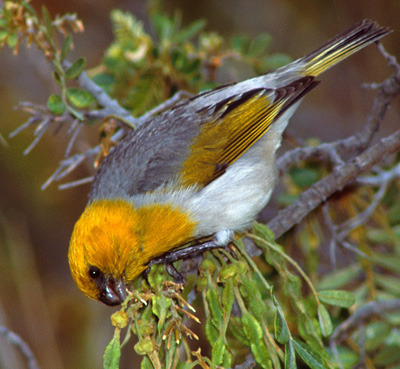
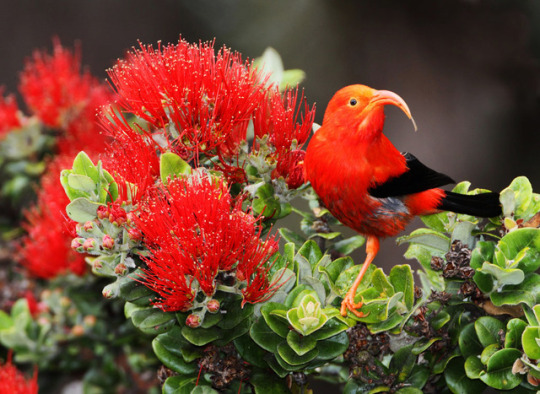

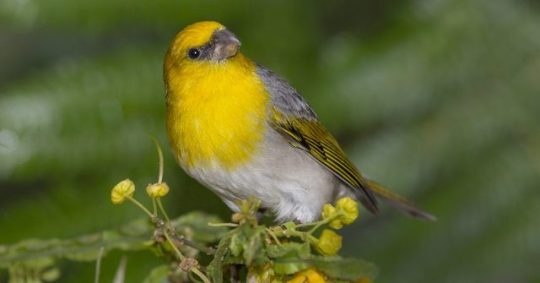
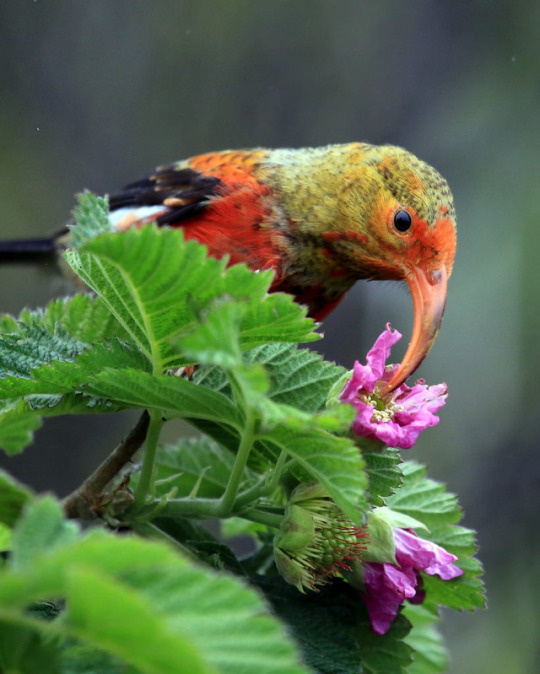
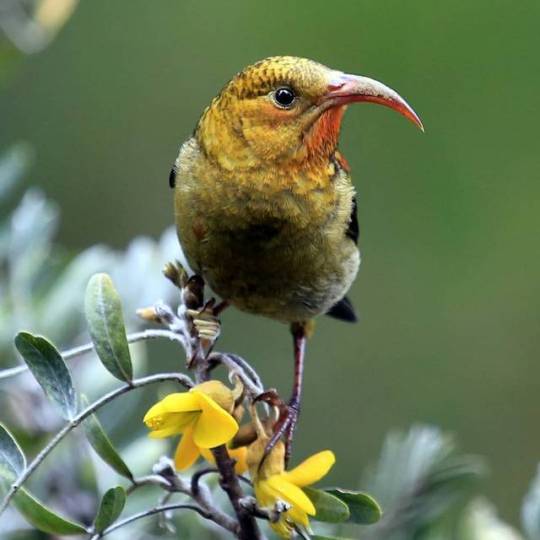
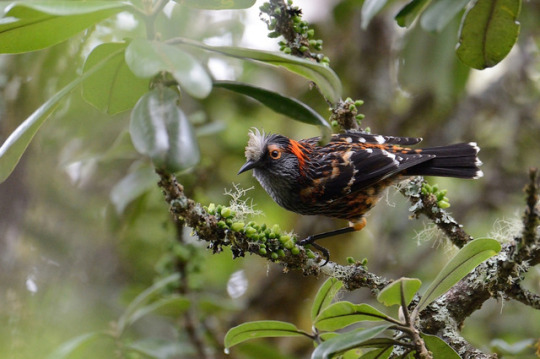
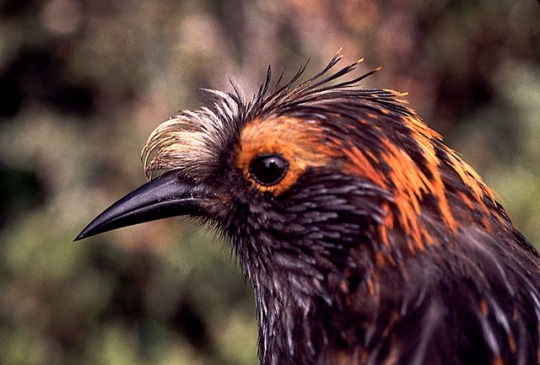
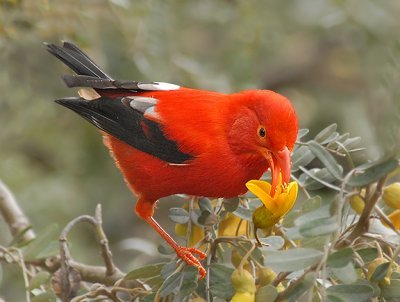
Hawaiian Honeycreeper
Hawaiian honeycreepers are small, passerine birds endemic to Hawaiʻi. They are closely related to the rosefinches in the genus Carpodacus. The group is divided into three tribes, but only very provisionally so. The wide range of bills in this group, from thick, finch-like bills to slender, downcurved bills for probing flowers have arisen through adaptive radiation, where an ancestral finch has evolved to fill a large number of ecological niches. Some 20 species of Hawaiian honeycreeper have become extinct in the recent past, and many more in earlier times, between the arrival of the Polynesians who introduced the first rats, chickens, pigs, and dogs, and hunted and converted habitat for agriculture.
Members of Psittirostrini, known as "Hawaiian finches", are granivorous with thick finch-like bills, and songs like those of cardueline finches. The group once covered the islands. Finch-billed drepanids include the Laysan finch, the Nihoa finch, the Maui parrotbill and the palila, which may be the last remaining species left alive in this group.
Hemignathini includes the Hawaiʻi creeper and its allies, such as the nukupuʻu. These are generally green-plumaged birds with thin bills, and feed on nectar and insects. Members of this group usually have green, yellow, orange, red, and gray feathers.
Species in the tribe Drepanidini are nectarivorous, and their songs contain nasal squeaks and whistles. Members of this group often have red black, yellow, white and orange plumage. It includes the ʻiʻiwi. Many species of this subfamily have been noted to have a plumage odor that has been termed the "Drepanidine odor", and is suspected to have a role in making the bird distasteful to predators.
#animal abc's#H#Hawaiian honeycreeper#i'iwi#scarlet honeycreeper#crested honeycreeper#palila#'amakihi#hawaiian finches#hawaiian animals#source: google
330 notes
·
View notes
Video
youtube
From **American Bird Conservancy Bird of the Week;
July 28, 2017**:
Hawai‘i 'Amakihi
SCIENTIFIC NAME: Chlorodrepanis virens
POPULATION: Approximately 800,000–900,000
TREND: Stable
HABITAT: Forests and shrubland at a wide range of elevations
One of the most common and adaptable of Hawaiian honeycreepers, the Hawai‘i 'Amakihi is found in all types of habitat, from sea level to 9,500 feet. Its presence at lower elevations seems to indicate that this species is evolving a tolerance to avian malaria, a disease spread by non-native mosquitoes that has driven species such as the ‘I‘iwi, a spectacular red honeycreeper, to higher elevations.

Although Hawai‘i ‘Amakihi populations appear stable, the birds are susceptible to the same threats facing other Hawaiian birds, including habitat loss and predation by introduced mammals such as rats and free-roaming cats.
A Separate Species
The Hawai‘i ‘Amakihi is currently found on three Hawaiian Islands: the Big Island, Maui, and Molokaʻi. It formerly occurred on the island of Lanaʻi but has not been seen there since 1976.
Genetic studies continue to fine-tune the evolutionary history of Hawaiian forest birds. For example, the Hawai‘i, Kaua‘i, and O‘ahu ‘Amakihi were once considered subspecies under the larger classification of Common ‘Amakihi. Recent research led to the classification of the Kaua‘i, O‘ahu, and Hawai‘i ‘Amakihi as three separate species.
Flexible Feeders
Hawai‘i ‘Amakihis finds food in a variety of ways, successfully foraging even in altered or degraded habitats. They glean tree bark and foliage for spiders and insects with their decurved bills, drink tree sap, and sip nectar from native flowers, including ‘ohi‘a and mamane, with tubular tongues.
These flexible feeders also eat fruit pulp and juice, and readily drink the nectar of non-native flowers and trees.
Productive Parents
Females of this species build an open-cup nest of grasses, twigs, and leaves lined with softer material such as lichen, rootlets, and animal hair. Males participate in the chick-rearing process by bringing food to the nest for the female and chicks. Even after fledging, young ‘Amakihi remain dependent on their parents for several weeks.

Hawaiian 'Amakihi feeding. Photo by Robby Kohley
This productive species usually raises two broods in a season, with the male taking over feeding duties for the first brood as the female begins the second. Hawai'i ‘Amakihi pairs remain together for successive breeding seasons.
Help Keep 'Amakihi Afloat
Hawai‘i ‘Amakihi have benefited from conservation work for other birds, including rare species such as Palila and Maui Parrotbill. ABC has collaborated with in-country partners on this work, which includes fencing habitat to keep it free of predators; controlling invasive species; and restoring forests.
We recently joined with several partner groups to ask Congress to support that would provide increased funding for endangered endemic birds.
Together with our partners, we're undertaking many conservation projects in Hawai‘i—but much remains to be done. You can help by supporting our Hawaiian Birds campaign before August 8!
#american bird conservancy#long post#bird calls#nature#wildlife#birds#finch#hawaiian honeycreeper#'amakihi#amakihi#Hawai'i 'Amakihi#Hawaii Amakihi
2 notes
·
View notes
Text

Today's bird is the Hawai'i 'amakihi!
212 notes
·
View notes
Photo

The Hawai‘i ‘Amakihi: fortunately still a fairly common bird in a state where many native birds have declined or gone extinct. With a tubular tongue for sipping nectar and tree sap, and a decurved bill for gleaning tree bark and foliage for spiders and insects, this species' adaptability has helped it remain more common than most other Hawaiian honeycreepers. See video: https://abcbirds.org/bird/hawaii-amakihi/ Photo of Hawai'i Amakihi by Robby Kohley #honeycreepersofinstagram #hawaiiamakihi #amakihi #birdsofhawaii #honeycreeper #birdsofinstagram #hawaiianbirds #americanbirdconservancy #pacificrimconservation #birdconservation #upsidedownbirds #nectaring
#hawaiianbirds#nectaring#birdsofhawaii#amakihi#americanbirdconservancy#birdconservation#pacificrimconservation#honeycreeper#birdsofinstagram#upsidedownbirds#hawaiiamakihi#honeycreepersofinstagram
19 notes
·
View notes
Photo

A Hawaii Amakihi browsing through Mamane flowers :). A couple years back I was working as a bioacoustic intern and was recording wild Palila vocalizations in the field. Most of the time when I was searching for Palila I would often see Amakihi flitting about the mamane-nail dry forest strands. Resulting in some great Amakihi photos. #amakihi #mamane #mamanenaioforest #puulaau #hawaiibirds #hawaii #bigisland #birds #honeycreepers #palila #bioacoustics #flowers #avians #cute #pretty #naturephotography #wildlifephotography #life #science (at Puu Laau)
#life#puulaau#naturephotography#avians#wildlifephotography#pretty#mamanenaioforest#mamane#cute#hawaii#honeycreepers#science#amakihi#hawaiibirds#palila#bioacoustics#birds#flowers#bigisland
2 notes
·
View notes
Text
Day 2 of Maui vacation
I meant to post more [at all] about how the vacation is going. However, traveling with Wife is a very busy and active affair without much downtime for that. But I’ll try to post belatedly. So, here’s what happened on Day 2:
Birdwatching tour!
(below the cut, more detail than anyone besides @lies wants about the birds we saw and also what happened with the broken fridge in the condo)
There are only about 50 species one is likely to see on Maui, and we saw 29 of them, including some forest birds which I had particularly hoped to see.
Our guide picked us up around 7:30am. It turned out it was just us and the guide, even though we hadn’t paid for a private tour. Apparently everyone else who wanted to birdwatch last week had wanted to go on Tuesday, so we lucked out.
We started at Kealia Pond National Wildlife Refuge, which used to be a fish farm. We saw 15 bird species there, including a huge number of Hawaiian black-necked stilts, lots of Hawaiian coots, some hybrids of mallards with Hawaiian ducks, both of the doves we’d been seeing around town (spotted and zebra), a couple of wandering tattlers, a family of black-crowned night-herons, and a Java sparrow which was adorable and looked a little like a tiny puffin. On our way out we passed a gray francolin, which was introduced here for hunting.
On our drive up to Haleakala National Park, we saw lots of common mynas (they’re everywhere in Hawaii), as well as a Pacific golden-plover and 2 Eurasian skylarks, a pair of ring-necked pheasants, and a few chukars. I hadn’t realised how many kinds of game birds had been introduced here for hunting!
We went up to the summit (about 10,000ft (3055m)), but it was completely clouded in, so we couldn’t see the views of the crater or the ocean. But we did see some fascinating lava rocks and interesting plants (silversword), and the observatory buildings.
Then we drove down to about 7000ft and had lunch (luckily there was a shelter with a picnic table under it, as it was still a bit drizzly there) before walking a short foresty trail with a few points overlooking a gulch. Two nenes (the Hawaiian goose) flew past while we were eating. On the walk we heard, but didn’t see, a Chinese Hwamei and a Maui Alauahio (though we may have had a glimpse of the latter), and we saw a bunch of `apapanes and even more `i`iwis as well as the Hawaii amakihi (Maui subspecies). The `i`iwis kept chasing the `apapanes away--both are fairly spectacular red birds (endemic to Hawaii) that like to feed on red flowers. I was particularly excited to see the `i`iwi since it is on the cover of my Hawaii bird book!
The drive down the mountain was treacherous at first, but atmospheric--we were literally inside a cloud with very poor visibility! The final site was a golf course. We birdwatched from the van, driving slowly along the road and stopping whenever we saw anything interesting. The most exciting birds there were the Java sparrows (so many tiny puffins!), scaly-breasted munias, chestnut munias, and red-crested cardinals. We also saw a mongoose, which is worrying--they eat the nene eggs and chicks. Then the guide dropped us off at about 4pm. A long day!
Since then (just to include most of the birdwatching content in one post), I’ve also seen rosy-faced lovebirds (released/escaped pet parrots) and warbling white-eyes from the balcony of the condo we were staying in.
Disappointingly, the broken refrigerator in the condo didn’t get replaced because the old one couldn’t be removed due to being blocked in by the newish washer and dryer. The owners gave us a partial refund (less than 10%) in compensation but it was a real shame because the kitchen was otherwise very nice and we would’ve liked to cook our own meals some of the time. That night we ate out at a nice restaurant instead.
5 notes
·
View notes
Text
Calling all bird nerds! Are you ready for the Hakalau Challenge?
By Holly Richards
Holly is an Public Affairs Officer with the U.S. Fish and Wildlife Service. She works in Honolulu,Hawaii.
What do you hear when you listen to the sounds of the forest? The wind in the leaves, the rustle of wildlife, the songs of the birds.
Listen refuge biologist Steve Kendall identify some of the birds he hears at Hakalau Forest National Wildlife Refuge and see how many different forest birds you can pick out. Once you’re done, scroll down to see and hear some of the birds identified. Good Luck! And may the birds be ever in your favor!
youtube
‘I‘iwi Vestiaria coccinea
This nectar feeding member of the honeycreeper family, with its brilliant scarlet body plumage and black wings and tail, abounds in the forest canopy where ‘ōhi‘a lehua blossoms are plentiful. The ‘i‘iwi's long, down curved, orange bill is specialized for sipping nectar from tubular flowers. The ‘i‘iwi’s "squeaky hinge” call can be heard throughout the forest when the birds are present.
‘Ōma‘ō Myadestes obscurus / Hawaiian Thrush
This bird has a dark brown back and a light gray breast. Birds are gray-brown above and lighter gray below, with a short, dark bill, a dark eye, and dark legs. As a member of the thrush family, Oma'os have a juvenile plumage pattern with heavy scalloping on the breast. The breast on juvenile birds is buffy-whitish in color, with black scalloped markings.
‘Apapane Himatione sanguinea
They are found on all main islands, primarily in native forest. Common on Hawai`i, Maui, and Kaua`i, uncommon on O`ahu, rare on Lana`i.
`Apapane are 5 inches. Both sexes look similar. The bodies are crimson red with a white abdomen and under tail coverts. The wings, tail, and legs are black. The bill is black and slightly curved. Juveniles are similar to adults except are a grayish-brown color. Their wings produce a distinct whirring sound in flight.
Hawai‘i ‘Amakihi Hemignathus virens
The Hawai‘i ‘amakihi is a small, generalist Hawaiian honeycreeper that occurs on the islands of Hawai‘i, Maui, and Moloka‘i. Until 1995, the Hawai‘i ‘amakihi, and the O‘ahu (H. flavus) and Kaua‘i ‘amakihi (H. kauaiensis) were considered a single species: the common ‘amakihi (H. virens).
Plumage of male Hawai‘i ‘amakihi is bright yellow-green above, and there is some inter-island variation, especially among females. Both have decurved bills.
They are generalized foragers that most often glean arthropods from the leaves, blossoms, twigs, branches, and less frequently from tree trucks of a variety of trees, ferns, and shrubs. They feed on nectar predominately from the flowers of ‘ōhi‘a, māmane, and native lobelias, but also forages on flowers of a number of other native and non-native plants.
For downloadable photos of the Hakalau Forest National Wildlife Refuge: https://www.flickr.com/photos/usfwspacific/
Learn more about Hakalau Forest National Wildlife Refuge.
#Hakalau Forest#Hakalau national wildlife refuge#forests#forest birds#birds#birdnerd#Birdnerds#birding#bird calls#hawaii#Big Island#USFWS#USFWS Pacific Region#iiwi#apapane#amakihi#omao#National Wildlife Refuge
3 notes
·
View notes
Photo

The Disappearing Songs of Hawaii’s Endangered Native Birds
The sounds of Kauai’s forests are changing. Thirty years ago, David Kuhn could hear a dawn chorus and identify the many different birds that lived on the Hawaiian island. But more recently, Kuhn, a wildlife recordist based on Kauai, began noticing that not only are the forests becoming quieter, it’s becoming increasingly difficult to tell the remaining birds apart by their songs.
Investigating further, in 2014 he recorded a native honeycreeper, an akekee, singing the songs of other endangered honeycreeper species. “That confirmed my confusion up to that point,” says Kuhn. “I thought, what the heck, these guys are starting to sound alike.”
Kuhn’s discovery prompted research into the plight of three of Kauai’s six remaining honeycreeper species: the anianiau, the Kauai amakihi, and the akekee. His hunch was correct — the three species now sing much more similar songs, with less complex vocal signals, due to the decreasing size of their populations, especially among mature birds that pass on song repertoires to younger offspring. It’s the first time this type of behavior among endangered birds has been recorded, says Kristina Paxton, lead author of a paper on honeycreepers published last year in the journal Royal Society Open Science, and a postdoctoral researcher in the Department of Biology at the University of Hawaii at Hilo.
There is far more at stake than the loss of beautiful songs. Birdsong plays an important role in mate attraction and selection, communication about food resources and predators, and the selection of breeding territories. The disappearance of songs can reduce the ability of bird populations to reproduce and survive, making life even more precarious for endangered forest birds like those on Kauai.
The songs are culturally transmitted — learned from parents and other birds in the environment where young birds are maturing. But if young birds don’t hear songs, they won’t learn them, and the lack of repertoire could create problems when it’s time to find a partner and reproduce. “I don’t think we often think about these behaviors that are also really critical to the survival of the species, and how the loss of those could also be a compounding effect of population loss,” says Paxton.
32 notes
·
View notes
Text
Apteribis

By Scott Reid
Etymology: Wingless Ibis
First Described By: Olson & Wetmore, 1976
Classification: Dinosauromorpha, Dinosauriformes, Dracohors, Dinosauria, Saurischia, Eusaurischia, Theropoda, Neotheropoda, Averostra, Tetanurae, Orionides, Avetheropoda, Coelurosauria, Tyrannoraptora, Maniraptoromorpha, Maniraptoriformes, Maniraptora, Pennaraptora, Paraves, Eumaniraptora, Averaptora, Avialae, Euavialae, Avebrevicauda, Pygostaylia, Ornithothoraces, Euornithes, Ornithuromorpha, Ornithurae, Neornithes, Neognathae, Neoaves, Aequorlitornithes, Ardeae, Aequornithes, Pelecaniformes, Threskiornithidae, Threskiornithinae
Referred Species: A. glenos (Molokai Flightless Ibis), A. brevis (Maui Flightless Ibis)
Status: Extinct
Time and Place: Between 200,000 years ago until sometime in the past 1000 years, from the Chibanian of the Pleistocene through the Holocene


Apteribis is known from the islands of Maui, Lanai, and Molokai

Physical Description: Apteribis looked, in a lot of ways, like your typical Ibis - it had a very long bill and skinny legs. Beyond that, though, it looked very different - it was more squat, for one, and it had a large round body. It also basically didn’t have any wings. This gave it, in a lot of ways, the appearance of a Kiwi, but it was an Ibis! We do have feathers from this animal that show it was brown in color, some darker brown and other feathers lighter brown of course but still overall brown - helping to add to that appearance like a Kiwi. And, like the living Kiwi, it was flightless.
Diet: There is nothing to suggest that Apteribis wasn’t like other Ibises, feeding mainly on invertebrates.
Behavior: Even though Apteribis was flightless, it still had hooklets in its feathers - usually used to provide structure in flight, for Apteribis they would have provided strength against stress in the wind and water. As such, Apteribis probably still contended with fairly perilous environments, probing through the waves or wading in strong wind to find food. It also probably spent a good amount of time looking for food in the litter of the forest floor, being associated strongly with the rainforests of Hawai’i. It would have used that long beak for probing, and its still skinny legs to carefully wade through whatever it was walking across. Beyond that, the rest of its behavior is uncertain - without flight, it wouldn’t have moved around much; and it probably would have taken care of its young.
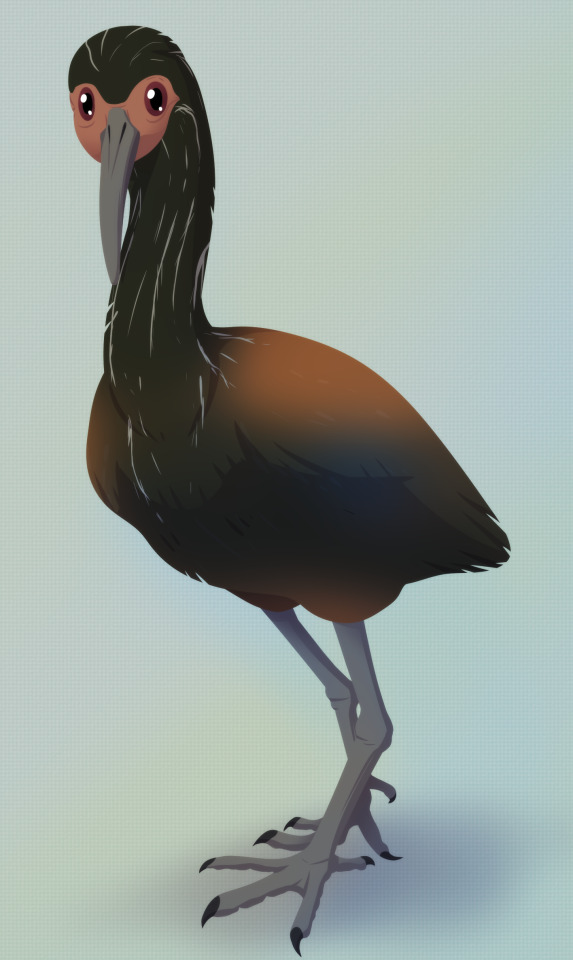
By José Carlos Cortés
Ecosystem: Hawai’i during the Ice Age was similar to Hawai’i today, just with some more arid conditions and different wildlife in general. Much like New Zealand, Hawai’i featured many kinds of unique birds, including Apteribis. There were also the Giant Hawaii Goose, a giant finch called the Giant Amakihi, the Giant Maui Crake, the High-Billed Crow, the Kaua’i Mole Duck, the Moa-Nalo, The Nēnē-nui, Stilt-Owls, and so many more.
Other: Apteribis did get quite big, but overall it wasn’t an example of island gigantism, just island flightlessness.
Species Differences: A. glenos lived primarily on the island of Molokai, while A. brevis was found more on Maui.
~ By Meig Dickson
Sources Under the Cut
Dove, C. J., S. L. Olson. 2011. Fossil Feathers from the Hawaiian Flightless Ibis (Apteribis sp.): Plumage Coloration and Systematics of a Prehistorically Extinct Bird. Journal of Paleontology 85 (5): 892 - 897.
Godino, F.M.J. (2011). "Maui Upland Apteribis". The Extinction Website. Retrieved 2011-01-07.
Olson, Storrs; James, Helen (1991). "Descriptions of Thirty-Two New Species of Birds from the Hawaiian Islands Part I. Non-Passeriformes". Ornithological Monographs. 7.
#Apteribis#Ibis#Bird#Dinosaur#Prehistoric Life#Paleontology#Prehistory#Apteribis glenos#Molokai Flightless Ibis#Apteribis brevis#Maui Flightless Ibis#Flightless Ibis#Aequorlitornithian#Ardeaen#Water Wednesday#Insectivore#Australia & Oceania#Quaternary#Factfile#Birblr#Palaeoblr#Birds#Dinosaurs#biology#a dinosaur a day#a-dinosaur-a-day#dinosaur of the day#dinosaur-of-the-day#science#nature
96 notes
·
View notes
